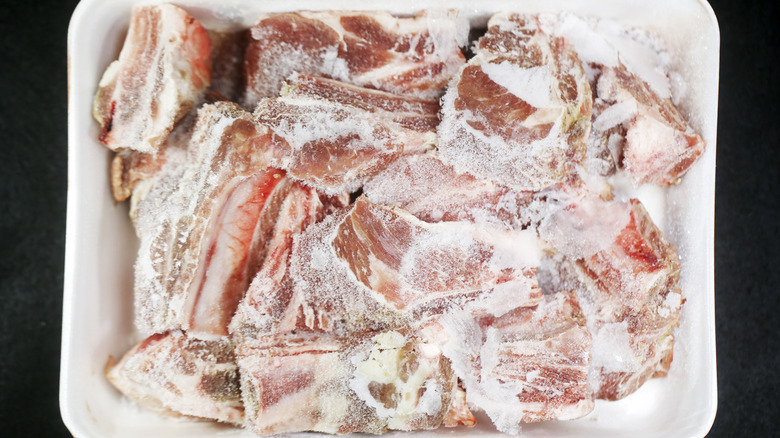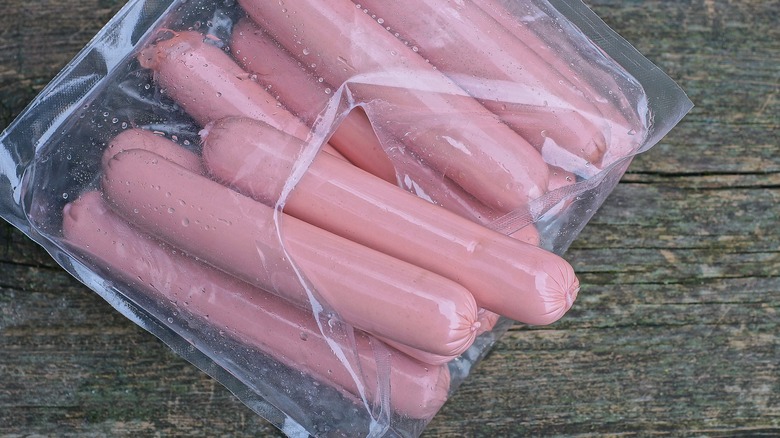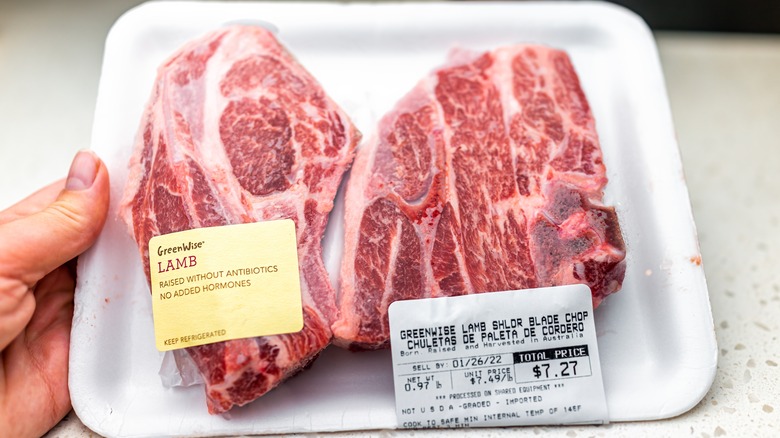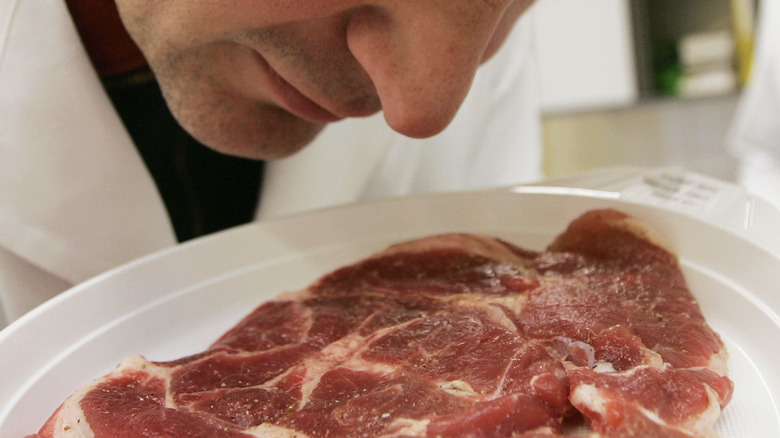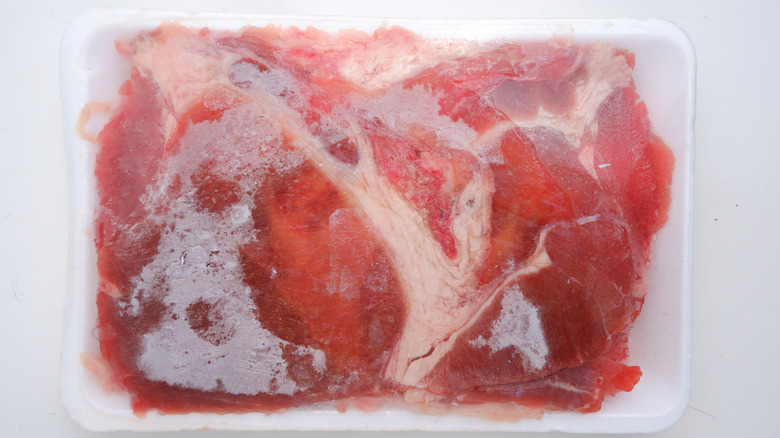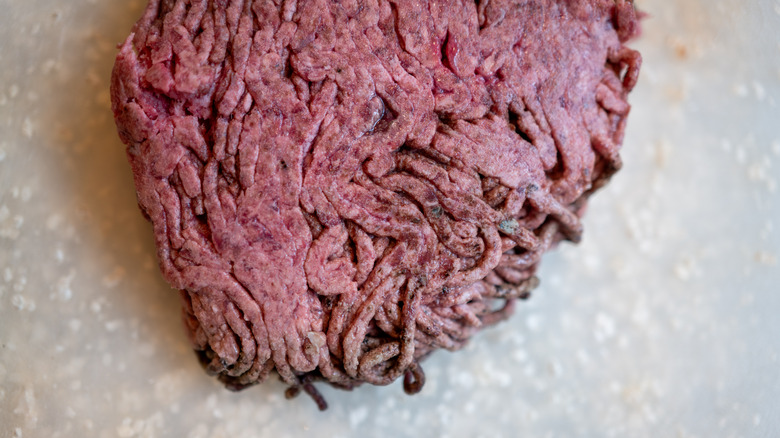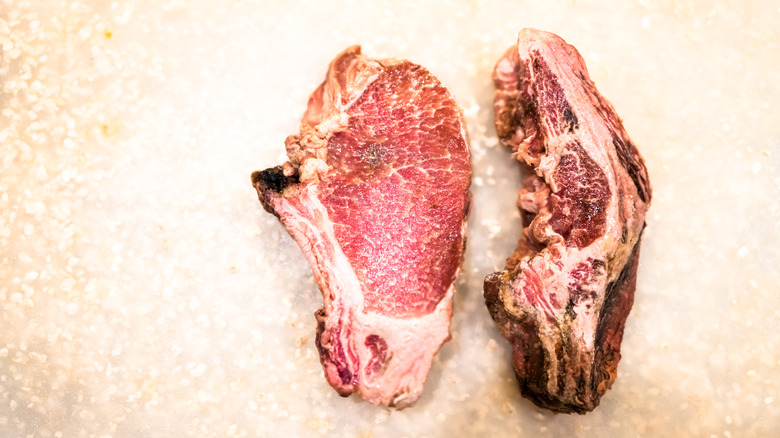8 Red Flags To Look For When Buying Frozen Meat
As a professional chef, I know the value of a premium cut of fresh meat. Nothing quite beats the flavor of a hand-cut steak at a fine dining restaurant or a farm-raised fresh turkey at Thanksgiving. That said, fresh meat is often cost-prohibitive, unavailable, or inconvenient to source in a timely fashion. While frozen meat may not have the same texture or flavor as fresh, it can make for a delicious meal — especially when carefully selected, stored, and prepared to perfection.
The first step to getting the best frozen meat is knowing what to look for when you go to the grocery store. There are a number of red flags that can indicate that the meat is spoiled, has not been stored properly, or has been in the freezer for too long. All of these can result in not just a disappointing meal, but one that could land you in the hospital if you are not careful.
While I often purchased meat for my restaurant from local farms or a reputable butcher, there were a number of occasions where I had to purchase frozen meat. When doing so, I put my five senses to use to inspect every cut, making sure it met my discerning standards. Read on to find out what I was looking, smelling, and feeling for before you stock up on that bulk meat bundle at your local grocery store.
1. Improper packaging
When you purchase fresh meat at a grocery store, it's often packaged on a styrofoam tray wrapped in plastic. Meat sourced directly from a butcher will generally be wrapped in a heavy duty packaging (known as butcher paper), and secured with tape or twine. While these are fine for short-term storage in the refrigerator, they are less than ideal for protecting meat when it's going to spend an extended period of time in the freezer. However, according to the United States Department of Agriculture, doing so is perfectly safe.
Before discussing this further, it may be helpful to understand what happens to meat when it gets frozen. Like with any food, excess water content within the muscle fibers of the meat will swell and crystallize. This process tends to make the meat softer when it thaws, which for some cuts may be beneficial, but for others — where a good chew is appreciated — can be a huge disappointment. The key to minimizing this effect on frozen meat is to eliminate as much excess oxygen as you can in the packaging, by either over-wrapping it or vacuum-sealing it.
When I source frozen meat, I prefer purchasing those that have been vacuum-sealed for quality. As noted, this will not impact the safety of the product for consumption. Ground beef, for example, is often found in vacuum-sealed logs by the pound, while other types of meat, like chicken drumsticks or wings, will be wrapped in an airtight bag.
2. Damaged packaging
While the USDA suggests that a torn or damaged package of meat in the freezer section of the grocery store may be safe to eat, there are a number of reasons why you may want to think twice about purchasing these products. First, you have no way of determining when this damage occurred. Was it at the meat packaging facility? Did it occur during transport? Was there a malfunction in the freezer that caused the meat to thaw partially and then refreeze, during which the packaging was compromised? Depending on when the damage happened, different levels of spoilage could have occurred, many of which could make the meat unsafe to consume.
Beyond this, the Food and Drug Administration brings up an even more salient reason to pay attention to how your meat is packaged in the freezer — the possibility of tampering. Though rare, the potential for deliberate tampering of food items leading to an outbreak of a food-borne illness is something to consider. For this reason, I always give the packaging surrounding the meat I am purchasing from the freezer section a careful once over. I look at the seal of the container, and the package itself for abrasions, cuts, or any holes that may cause the meat to come into contact with other surfaces or would allow for oxygen to permeate the encasement. If I notice these, I simply skip it and search for an intact, undamaged product.
3. The presence of ice crystals
The presence of obvious ice crystals on meat leads to another discussion that is often misunderstood — freezer burn. Though there is no heat involved, the term freezer burn refers to a scientific process during which moisture is lost from the exterior surface of the meat as it remains in cold temperatures for an extended period of time. This desiccation results in the meat becoming discolored, wrinkly, and developing little spots that look like burns on the surface of the meat.
Freezer burn cannot be reversed, and its presence will result in a taste and flavor that is less than ideal, once the meat has been thawed and prepared. That said, as the USDA notes, there is nothing inherently unsafe about eating meat that has been afflicted by freezer burn. Simply trim off the damaged portions and cook the meat as desired. However, meat that has experienced excessive freezer burn (that permeates the entire cut) should likely be discarded, as the quality will be far too compromised to enjoy.
To avoid freezer burn, meat should be properly stored in an airtight container for no longer than 12 months within a freezer that has been well-maintained, and holds a consistent temperature of 0 degrees Fahrenheit. As a chef, I tend to be quite selective, and will forgo meat with even the slightest evidence of freezer burn to maintain the highest quality I possibly can, but doing the same is up to you.
4. Inadequate labeling
Proper labeling is crucial. It can tell you about the nutrition, allergens, and freshness of a food item. That said, when it comes to meat, some labels can be confusing and misleading, like "all-natural" or "no hormones added." This does not diminish the importance of properly labeled meat. All meat is required by the USDA-FSIS to include the product name, inspection legend, address, net weight or quantity, and an ingredient statement. Additional information often reflects safe handling instructions, nutrition information, and the sell-by date. Labels may get torn, lost, or otherwise compromised during the freezing process. If a meat product being sold in the freezer section of the grocery store is missing any of this information, steer clear of purchasing it.
The second factor to consider when it comes to labels is the sell-by date. According to the USDA, meat that has been frozen at 0 degrees Fahrenheit can last indefinitely in terms of safety. That said, just because you can consume meat that has been frozen for two years, doesn't mean you should. When it comes to quality, there are some recommendations that should be followed. Depending on the precise cut and type of meat, most products should be consumed within 12 months of freezing. While this may be challenging to determine, as a general rule of thumb, if the purchase date is more than a year after the sell-by date, I avoid buying that frozen meat.
5. A foul smell
One of the most dependable ways to determine the freshness of meat is to smell it. Fresh meat should have an odor that ranges from sweet to mineral-forward, depending on the type. As the meat putrefies, cadaverine, putrescine, and other amines are released, resulting in a distinctive, overwhelming, ammoniated aroma — similar to that of rotten eggs. While the cold temperatures of the freezer tend to neutralize odors, making scent a less reliable method for ascertaining the freshness of meat, if you do detect any kind of foul scent, this may be a sign that the temperature is not holding at 0 degrees Fahrenheit or lower, which can mean the meat is unsafe to consume and that you should probably avoid purchasing it.
That said, there is a caveat to this, when it comes to vacuum-sealed meat. Meat that has been properly vacuum-sealed can develop a somewhat sour, sulfuric aroma, owing to lactic acid accumulation within the packaging. Generally speaking, this aroma should dissipate within half an hour of opening the thawed package of meat. That said, if it does not, this may be a sign of spoilage. I tend to err on the side of caution, using the FDA's own mantra: "When in doubt, throw it out," especially when I'm dealing with ground meat of any kind.
6. The meat is resting in frozen puddle
If you have ever wondered why meat is often packaged atop an absorbent pad, this is because meat continues to release a combination of water and myoglobin after it has been butchered. These juices can be the breeding ground for dangerous pathogens that can cause food-borne illnesses. The silica or cellulose pads help to wick this infectious liquid away from the meat, helping to keep it safe. That said, excess liquid can build up in packages of meat, particularly those that are vacuum-sealed. When frozen, this will leave behind a distinct puddle of ice crystals within the packaging, which can mean the meat has not been stored safely.
One way meat producers minimize this pooling in frozen meat is to flash-freeze it. Flash-freezing involves transferring the meat to sub-zero temperatures, where it can freeze much more rapidly than if it had been left at higher temperatures. Flash-frozen meat tends to leach less moisture, resulting in fewer ice crystals forming, which can improve the safety and quality of the final product. The result is a steak or pork chop that is decidedly less squishy or mealy after it has been cooked, giving it a better mouthfeel. Regardless of whether meat has been conventionally frozen or flash-frozen, if you notice a puddle of ice at the bottom of the packaging, you may want to avoid purchasing and consuming the meat.
7. Textural changes
While you may not be able to tell this until you get the meat home and thaw it, obvious textural changes are a telltale sign that the safety and quality of the meat are suspect. These may have occurred before the meat was frozen or may indicate that the meat was not held at a safe temperature of 0 degrees Fahrenheit. Either way, let your eyes and fingers be your guides. Meat that is overtly tacky or slick after it has been thawed has likely been impacted by pathogens, and should be avoided. Alternatively, meat can begin to look desiccated, and have a grainy texture, even in its frozen state. This indicates improper storage, which may not impact safety, but will definitely diminish the quality of the cooked steak or pork chop.
Another phenomenon — which is particularly evident with whole turkeys purchased around the holidays — are obvious changes in the shape of the frozen bird. This will generally be most noticeable in the breast meat of the turkey, which may have distinct indentations, indicating the bird was not held at 0 degrees Fahrenheit and may be unsafe to consume. Again, if you aren't sure, skip it, especially with poultry. There is no reason to take a risk when roasting up a Thanksgiving turkey.
8. Discoloration
One final telltale sign that meat may not be fit for consumption is its color. Again, while this may be more difficult to ascertain in its frozen state, even frozen meat can have distinctive color changes that are worth taking note of. Typically, when fresh beef begins to turn, its color will shift to a khaki hue, pork will become a dull gray color, and chicken may shift from a blushing pink to a tawny tone. If meat that is past its prime is frozen, you may see indications of these color shifts on the meat.
In contrast, meat that has been freshly frozen may not undergo notable color changes, unless it has been carelessly packaged, stored for too long a period of time, or thawed and refrozen. The USDA suggests that beef can transition from a bright red to a muted brown tone, while poultry itself won't change in color unless pigment from damaged bones has leached into the meat. While changes in coloration may not indicate that the meat is unsafe, quality may be compromised. For this reason, it may be worthwhile to choose another package that is less obviously impacted by changes in the coloration of the flesh of the meat.

